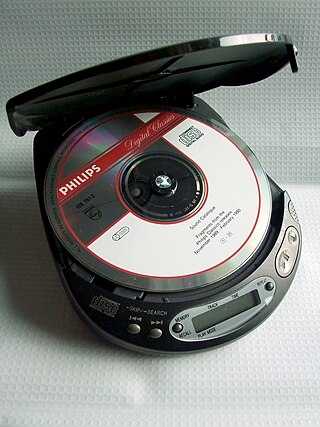
The compact disc (CD) is a digital optical disc data storage format that was co-developed by Philips and Sony to store and play digital audio recordings. It uses the Compact Disc Digital Audio format which typically provides 74 minutes of audio on a disc. In later years, the compact disc was adapted for non-audio computer data storage purposes as CD-ROM and its derivatives. First released in Japan in October 1982, the CD was the second optical disc technology to be invented, after the much larger LaserDisc (LD). By 2007, 200 billion CDs had been sold worldwide.

CD-R is a digital optical disc storage format. A CD-R disc is a compact disc that can only be written once and read arbitrarily many times.

An optical disc is a flat, usually disc-shaped object that stores information in the form of physical variations on its surface that can be read with the aid of a beam of light. Optical discs can be reflective, where the light source and detector are on the same side of the disc, or transmissive, where light shines through the disc to be detected on the other side.

Compact Disc Digital Audio, also known as Digital Audio Compact Disc or simply as Audio CD, is the standard format for audio compact discs. The standard is defined in the Red Book technical specifications, which is why the format is also dubbed "Redbook audio" in some contexts. CDDA utilizes pulse-code modulation (PCM) and uses a 44,100 Hz sampling frequency and 16-bit resolution, and was originally specified to store up to 74 minutes of stereo audio per disc.

Video CD is a home video format and the first format for distributing films on standard 120 mm (4.7 in) optical discs. The format was widely adopted in Southeast Asia, South Asia, East Asia, Central Asia and West Asia, superseding the VHS and Betamax systems in the regions until DVD-Video finally became affordable in the first decade of the 21st century.

Digital Audio Tape is a signal recording and playback medium developed by Sony and introduced in 1987. In appearance it is similar to a Compact Cassette, using 3.81 mm / 0.15" magnetic tape enclosed in a protective shell, but is roughly half the size at 73 mm × 54 mm × 10.5 mm. The recording is digital rather than analog. DAT can record at sampling rates equal to, as well as higher and lower than a CD at 16 bits quantization. If a comparable digital source is copied without returning to the analogue domain, then the DAT will produce an exact clone, unlike other digital media such as Digital Compact Cassette or non-Hi-MD MiniDisc, both of which use a lossy data-reduction system.

A CD player is an electronic device that plays audio compact discs, which are a digital optical disc data storage format. CD players were first sold to consumers in 1982. CDs typically contain recordings of audio material such as music or audiobooks. CD players may be part of home stereo systems, car audio systems, personal computers, or portable CD players such as CD boomboxes. Most CD players produce an output signal via a headphone jack or RCA jacks. To use a CD player in a home stereo system, the user connects an RCA cable from the RCA jacks to a hi-fi and loudspeakers for listening to music. To listen to music using a CD player with a headphone output jack, the user plugs headphones or earphones into the headphone jack.

The White Book refers to a standard of compact disc that stores not only sound but also still pictures and motion video. It was released in 1993 by Sony, Philips, Matsushita, and JVC. These discs, most commonly found in Asia, are usually called "Video CDs" (VCD). In some ways, VCD can be thought of as the successor to the Laserdisc and the predecessor to DVD. Note that Video CD should not be confused with CD Video which was an earlier and entirely different format.

Optical disc authoring, including CD, DVD, and Blu-ray Disc authoring, is the process of assembling source material—video, audio or other data—into the proper logical volume format to then be recorded ("burned") onto an optical disc. This act is sometimes done illegally, by pirating copyrighted material without permission from the original artists.

CD+G is an extension of the compact disc standard that can present low-resolution graphics alongside the audio data on the disc when played on a compatible device. CD+G discs are often used for karaoke machines, which use this functionality to present on-screen lyrics for the song contained on the disc. The CD+G specifications were published by Philips and Sony as an extension of the Red Book specifications.
Taiyo Yuden Co., Ltd. is a Japanese materials and electronics company, situated in Kyobashi, Chuo, Tokyo, that helped pioneer recordable CD technology (CD-R) along with Sony and Philips in 1988. Founded 70 years ago, Taiyo Yuden currently operates factories in Japan, Singapore, Korea, China, the Philippines, Taiwan, and Malaysia.

Extended Resolution Compact Disc (XRCD) is a mastering and manufacture process patented by JVC for producing Red Book compact discs. It was first introduced in 1995.

DVD recordable and DVD rewritable are a collection of optical disc formats that can be written to by a DVD recorder and by computers using a DVD writer. The "recordable" discs are write-once read-many (WORM) media, where as "rewritable" discs are able to be erased and rewritten. Data is written ('burned') to the disc by a laser, rather than the data being 'pressed' onto the disc during manufacture, like a DVD-ROM. Pressing is used in mass production, primarily for the distribution of home video.
Disc rot is the tendency of CD, DVD, or other optical discs to become unreadable because of chemical deterioration. The causes include oxidation of the reflective layer, reactions with contaminants, ultra-violet light damage, and de-bonding of the adhesive used to adhere the layers of the disc together.

Compact disc manufacturing is the process by which commercial compact discs (CDs) are replicated in mass quantities using a master version created from a source recording. This may be either in audio form (CD-DA) or data form (CD-ROM). This process is used in the mastering of read-only compact discs. DVDs and Blu-rays use similar methods.

CD-RW is a digital optical disc storage format introduced in 1997. A CD-RW compact disc (CD-RWs) can be written, read, erased, and re-written.
The preservation of optical media is essential because it is a resource in libraries, and stores audio, video, and computer data. While optical discs are generally more reliable and durable than older media types, environmental conditions and/or poor handling can result in lost information.

A CD-ROM is a type of read-only memory consisting of a pre-pressed optical compact disc that contains data computers can read, but not write or erase. Some CDs, called enhanced CDs, hold both computer data and audio with the latter capable of being played on a CD player, while data is only usable on a computer.

The Art of Control is the eighth studio solo album by Peter Frampton, released in 1982 on A&M Records. It was his last for the label.
Blu-spec is a rarely-used format of compact disc made using production techniques similar to Blu-ray discs, but were readable with standard compact disc players. The alleged benefit of these was in the playback accuracy. The back catalogue of mainstream artists were released in this format.













